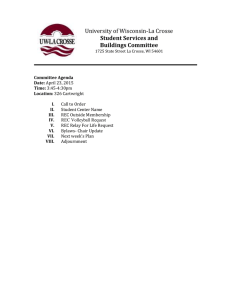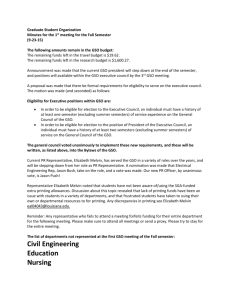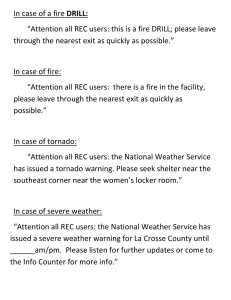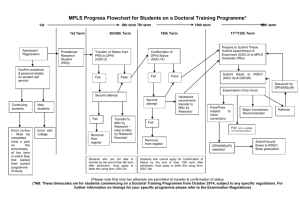ESTIMATION of the METHODS of the EFFICIENT USE of the GSO SPECTRUM/ORBIT RESOURCE КАNТОR L.Ya.
advertisement
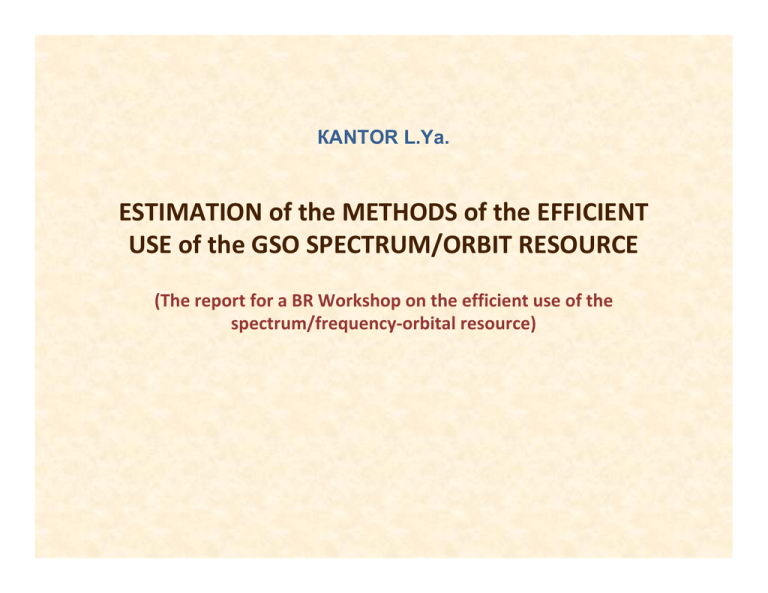
КАNТОR L.Ya. ESTIMATION of the METHODS of the EFFICIENT USE of the GSO SPECTRUM/ORBIT RESOURCE (The report for a BR Workshop on the efficient use of the spectrum/frequency‐orbital resource) Insufficiency of the spectrum/orbit resource in the geostationary orbit is evident to-day for the actually operating satellites. Actual GSO overload takes place. It would be important to consider the technical and regulatory measures directly increasing the real GSO resource whereas problems of "paper" satellites or imperfection of current procedures are not so urgent any more. 2 Technical methods of the GSO capacity increasing are well‐known: • Increase of the spatial selectivity of earth antennas, including by interference compensation method; • Increase of the spatial selectivity of satellite antennas; • Frequency reuse; • Effective modulation and encoding technique; • Usage of higher frequency bands; • Homogeneity of systems operating in shared frequency band; • Principle of beam intersection (close positions provide service to remote areas); • Signal processing onboard the satellite, etc. 3 Regulatory measures, which could promote increase of accessible spectrum/orbit‐frequency resource: •Including in service and coverage areas only the territory on wich the proposed assignment will be really used; •Minimum difference between service and coverage areas; •Restriction the range of the main technical parameters values of submitted systems; •Increasing the value of permissible intersystem interference; •Promotion of the use of other orbits which do not reduce GSO capacity. The purpose of the present report is to give quantative estimations of the efficiency of some of these methods. 4 Influence of spatial selectivity of antenna on the number of satellites in the geostationary orbit Improvement of earth antennas spatial selectivity from b(32‐25lg, Rec. ITU‐R S.580) to (29‐25lg, Rec. ITU‐R S.465) allows to place up to 70 80 additional systems in GSO (for homogeneous systems). D = 1,2 m C/I 10 15 20 25 30 Gmax*=41.9 dB Rec. 580 271 297 187 118 75 Rec. 465 271 225 142 90 57 PROFIT 0 72 45 29 18 D = 2,0 m C/I 10 15 20 25 30 Gmax*=46.4 dB Rec. 580 452 369 283 179 113 Rec. 465 452 369 215 136 86 PROFIT 0 0 68 43 27 D = 2,7 m C/I 10 15 20 25 30 Gmax*=49.0 dB Rec. 580 610 498 360 227 143 Rec. 465 610 498 273 172 109 PROFIT 0 0 87 55 35 *f=11,0 GHz 5 Effect of the usage of systems with homogeneous parameters GIBC calculation to examine compatibility of the systems submitted to ITU in 21.4‐ 22.0 GHz band for coordination within arc 36E ±8°: a). with parameters of notices, b). with equal diameters of earth antennas (at clear sky), c). with equal diameters of earth antennas under rain‐faded conditions corresponding to the same availability, d). with parameters of notices and service and coverage areas restricted to the national territory. a b c Dаes = 0.6 m, Тes= 180 К At notices parameters С/N = 20 clear sky С/N = 14 atmospheric losses d At notices parameters Limited zones Number of calculations 546.0 415.00 415.00 546.0 ΔT/T > 6% 90.7% 82.9% 85.5% 23.3% ΔT/T < 6% 9.3% 17.1% 14.5% 76.7% 6 Effect of the interference criterion type Number of cases with ΔT/T>6% but C/I is higher than established criterion a b c Dаes = 0.6 m, Тes= 180 К At notices parameters С/N = 20 clear sky С/N = 14 atmospheric losses d At notices parameters Limited zones C/I > 14 дБ 18.2% 70.6% 49.6% 25.2% C/I > 20 дБ 8.7% 54.4% 22.8% 15% This table represents a quantitative estimation of effect from application of С/I criterion instead of ΔТ/Т one. 7 The influence of earth antenna size (expressed through maximum gain) on maximum theoretical GSO capacity (according to Shannon) by the assumption of ideally homogeneous systems. Capacity 360 log 2 (1 N 1 C ) F T NI C C NI I I I ( ) I( 2 ) 2 2 C C C I ( ) ‐ according to Rec. ITU‐R S.580 C The result of this analysis presented on the next slide enables to determine optimum value of angular separation of adjacent systems and optimum value of С/I criterion. 8 Capacity, bit/Hz/sec 5000.0 4500.0 4000.0 3500.0 3000.0 2500.0 2000.0 1500.0 1000.0 500.0 0.0 0 1 Gmax = 30 dB 2 Gmax = 35 dB 3 4 Gmax = 40 dB 5 6 Gmax = 45 dB 7 Gmax = 50 dB 8 9 θ, ⁰ Gmax = 55 dB 9 GSO capacity (without taking into account satellite antennas selectivity, only for down-link) amounts from 164 to 4400 bit/GHz/s. Optimum values of angular separation of adjacent systems are located from 5.8° to 0.45°, optimum С/I values are from 7.2 dB to 16.5 dB, and it could be taken into account when revising the current criteria. 10 The initial estimation of overall GSO capacity gave values from 1.6 up to 11.25 bit/s/GHz/degree (Jansky, Jeruchim, 1983; CCIR, Doc. IWP4 /1/1008,1983, Doc.4/20,1985). The maximum capacity of the geostationary orbit was also estimated (Kantor, Timofeev, 1988): СGSO = 5S/θ0,5β20,5 bit/s/GHz/degree, where S surface radiated from GSO (in terms of a solid angle), θ0,5 angle between adjacent uniform systems, β0,5 width of the elementary satellite beam. By assumption of only land coverage, СGSO = 200 400 bit/s/GHz/degree. ITU studies [ITU‐R, Doc 4A/234, 4A/307, period of 2003‐2007 (UK), Rec. S.1782], concerning particular construction of VSAT FSS systems with multibeam structure, have given values from 140 bit/s/GHz/degree up to 9000 bit/s/GHz/degree. 11 In connection with GSO overload, using other types of orbits becomes important. High elliptical orbits (HEO) with high inclination are attractive because FSS in such orbits can carry out some of the geostationary systems functions without any damage for geostationary systems capacity. Calculation has shown that it is possible to place up to 90 systems in orbit type “Molniya” at minimum angular space separation of 2 degrees between satellites of adjacent systems (under condition of satellite in‐phase motion). At out‐of‐phase satellite motion the number of possible systems in such orbit decreases to 45. Usage of orbits with other inclination will allow additional increase of number of compatible systems in HEO. 12 Conclusion: Potential frequency-orbital resource is essentially above than really used Thanks for attention. 13

